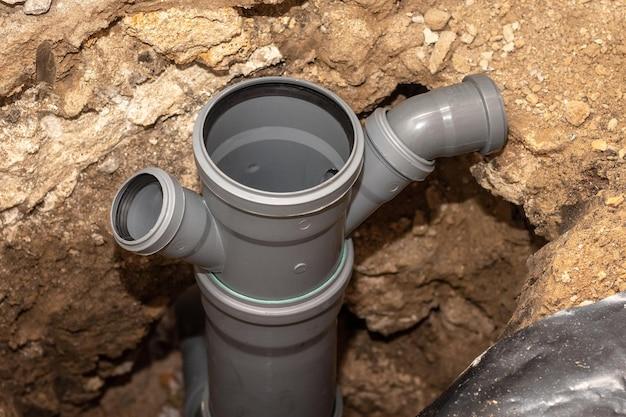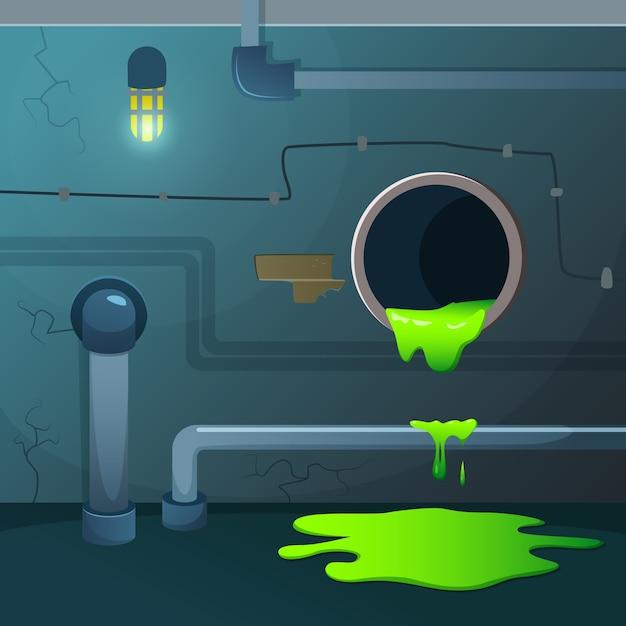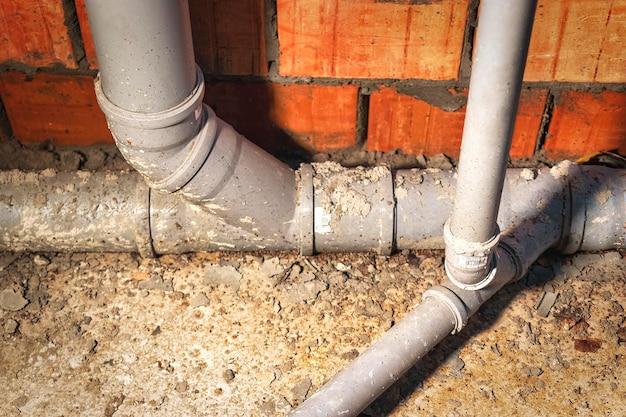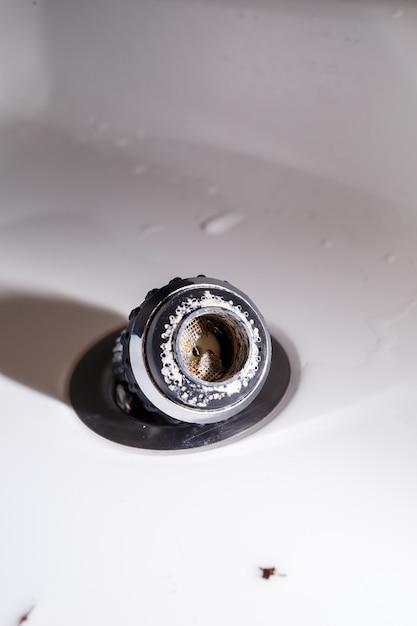Are you experiencing a sewage backup in your bathroom? You’re not alone! This is a common problem that many homeowners and renters face. A sewage backup can quickly turn your bathroom into a hazardous and unpleasant space, leaving you feeling overwhelmed and frustrated. In this blog post, we will discuss the causes of sewage backup in bathroom, signs to watch out for, and the solutions to fix this problem. We will also explore the dangers of having sewage in your bathroom and why it’s essential to address the issue as soon as possible. So, stick around, and let’s dive into the dirty truth about sewage backup in the bathroom!
Signs of Sewage Backup in Your Bathroom
Have you ever walked into your bathroom to find a putrid smell and overflowing water from your toilet? It’s not only unpleasant but also hazardous to your health. This could be a sign of sewage backup, a common problem that affects many homes.
Strange Sounds
When you hear strange gurgling noises coming from your toilet and drains, it could be a sign that your sewage system is backed up. The gurgling sound is caused by air pockets that form in the plumbing system when the sewage can’t flow through.
Slow or Clogged Drains
When you notice water taking longer than usual to go down your sink or shower drain, it could indicate a sewage backup. You may also hear gurgling sounds from these drains.
Foul Odors
Another sign of sewage backup is a foul odor from your bathroom. The smell could be coming from your toilet or sink drains. Sewage backup can release methane gas that smells like rotten eggs. This smell should not be taken lightly as it can be dangerous to your health.
Water Backup
When water begins to come back up your toilet, shower or sink, that’s a clear indication of a sewage backup. Water backup can be contaminated, and this could cause health problems if not sorted out urgently.
Don’t Ignore These Signs
Sewage backup in your bathroom is not only unpleasant but also a health hazard. If you notice any of these signs, it’s important to act fast and get a professional to help you clear the blockage. Ignoring the problem could result in more significant issues such as flooding, mold growth, and even structural damage.
By understanding these signs, you can prevent a sewage backup in your bathroom and keep your home safe and comfortable for you and your guests.
Sewage Backup Toilet
When it comes to discussing bathroom issues, nothing can be more embarrassing than a sewage backup. Imagine having a house full of guests, and suddenly the toilet overflows, spilling raw sewage all over the floor. It’s not only disgusting, but it’s also a potential health risk.
Causes of Sewage Backup in the Toilet
There are various reasons why a toilet could back up with sewage, including:
Clogs and Blockages
Toilets can become clogged due to the buildup of waste, grease, and debris over time. In some cases, items like paper towels, feminine hygiene products, and toys can cause blockages, resulting in sewage backup.
Old Pipes
If you have old pipes, they may become corroded or damaged over time, making it difficult for waste to flow through and causing a sewage backup.
Tree Roots
Tree roots can grow into pipes and cause blockages. They can also invade existing cracks and joints in pipes, causing the pipes to break or collapse, resulting in sewage backup.
Signs of Sewage Backup in the Toilet
It’s crucial to recognize the warning signs of sewage backup in the toilet before it’s too late. Some of the common signs include:
Slow Draining
If you notice that your toilet is draining slowly, it could be a sign of a clog or blockage in the pipes.
Unpleasant Odors
If you smell unpleasant odors coming from your toilet, it could be caused by a backup of sewage.
Gurgling Sounds
If you hear gurgling sounds coming from your toilet when you flush, it could be due to a clog or blockage in the pipes.
Tips for Dealing with Sewage Backup in the Toilet
If you experience a sewage backup in the toilet, here are some tips to help you out:
Turn off the Water
If you notice an overflow, turn off the water valve to the toilet to prevent further damage.
Use a Plunger
Try to use a plunger to unclog the toilet. However, if the water is already overflowing, it may be too late for a plunger to work.
Call a Professional
If you’re not sure how to deal with the issue, it’s best to call a professional plumber or sewage cleanup service to handle the situation.
In conclusion, a sewage backup in the toilet is an unfortunate event that can happen to anyone. However, by recognizing the signs, taking preventive measures, and knowing what to do when it happens, you can minimize the damage and keep your house safe and healthy. Remember to always call a professional if you’re unsure how to deal with the issue.
Sewage in Bathtub Dangerous
Have you ever woken up to a nasty surprise of sewage backup in your bathtub? It’s not only gross and inconvenient, but it can also be a health hazard. Here are some of the dangers of having sewage in your bathtub.
Bacteria and Viruses
Sewage is teeming with bacteria and viruses that can cause serious illnesses. Exposure to sewage in your bathtub can lead to gastrointestinal problems, respiratory infections, and skin irritations. Even a small amount of contact with contaminated water can lead to infection.
Chemical Contamination
Sewage contains chemicals and other harmful substances that can cause serious damage to your health. These include heavy metals, pesticides, and pharmaceuticals. These toxins can be absorbed through your skin and can lead to serious health problems over time.
Structural Damage
Sewage backup in your bathtub can be a sign of a more serious problem within your plumbing system. The excess water and pressure can cause pipes to burst, leading to expensive damage to your home’s structure and furnishings.
Bad Odors
Sewage backup in your bathtub can create a foul odor that lingers in your home, making it unpleasant to live in. It can be hard to eliminate the smell without professional help, and it can impact your quality of life.
In conclusion, having sewage backup in your bathtub is not only disgusting and annoying but also a serious health hazard. It’s best to call a professional plumber as soon as possible to address the issue and prevent further damage. Don’t let sewage ruin your day, and protect yourself and your family from the dangers it poses.
Apartment Bathtub Backing Up
If you’re a seasoned apartment dweller, you’re probably no stranger to the joys of living in a high-rise. The bird’s-eye view of the city, the proximity to work, the shared walls with your neighbors who seem to have an endless supply of energy at 3 am – the perks are endless. But there’s one aspect of apartment living that can quickly turn a dream home into a nightmare: the dreaded bathtub backup.
The Signs of Trouble
You know the feeling – you’re taking a relaxing bubble bath after a long day, and the water starts rising instead of draining. You try to convince yourself that it’s just a fluke, that maybe you’ve accidentally let the stopper stay closed, or that the problem will resolve itself if you just wait a bit. But deep down, you know what’s coming. And sure enough, before you know it, you’re calling the building manager and bracing yourself for the inevitable – a visit from the plumber.
The Causes of Trouble
So what causes this issue? There are a few potential culprits. For one thing, apartment plumbing systems can be notoriously finicky, especially in older buildings. Something as simple as a little bit of hair or soap scum can cause a clog, and with so many people using the same pipes, it’s only a matter of time before the system starts to back up.
Another possible cause is simply the apartment’s location – if you live on the lower floors, you may be more susceptible to backups caused by issues further up the pipe. And if your building is connected to a larger plumbing system (like what you might find in a commercial building), the problem could be even more widespread.
The Solutions to Trouble
So what can you do if you find yourself facing a bathtub backup? First and foremost, don’t panic. This is a common issue, and your building manager should be equipped to handle it. If you’re worried about the cost of repairs, you can always communicate with your landlord and see if there’s a way to split the cost or work out a payment plan.
If you’re prone to backups and want to take preventative measures, there are a few things you can do. Use a drain cover to catch hair and soap scum, and be careful about what you flush down the toilet (remember, “flushable” wipes aren’t always as flushable as they claim to be!).
Living in an apartment can be a wonderful experience, but it’s not without its challenges. If you’re dealing with a bathtub backup, remember that you’re not alone – and that there are solutions out there. With a little bit of patience (and maybe a lot of bubble baths), you’ll get through this in no time.
Toilet Backing Up When Flushed
Do you dread flushing your toilet because you’re afraid it might back up and flood your bathroom with sewage? Don’t worry; you’re not alone. Toilet backups are a common home plumbing problem, but one that should not be taken lightly. Here are some tips on how to fix a toilet that is backing up when flushed:
1. Check the Toilet for Clogs
The most common reason for a toilet to back up is a clogged toilet drain. When a toilet is flushed, the water and waste go through a pipe and into a larger drain line. If there is a blockage in the toilet, the water has nowhere to go, and it will back up into the toilet bowl. To fix this, you can use a plunger or a toilet auger to remove the clog.
2. Don’t Flush Non-Flushable Items
Many people flush things down the toilet that shouldn’t be flushed, such as feminine products, baby wipes, and paper towels. These items don’t break down like toilet paper, and they can easily clog your toilet drain. To avoid this problem, only flush toilet paper and human waste down the toilet.
3. Check the Water Level in the Tank
If the water level in the tank is low, the toilet may not flush correctly, causing the water to back up into the bowl. To fix this problem, open the tank lid and check the water level. If it’s low, adjust the water level to the fill line.
4. Call a Professional
If you’ve tried all the above suggestions, and your toilet still backs up when flushed, it’s time to call in a professional plumber. They can use a variety of methods, such as a hydro-jetting service or a camera inspection, to diagnose and fix the problem.
In conclusion, toilet backups can be a messy and distressing problem, but with the right techniques and preventative measures, you can avoid this problem in the future. Remember, if all else fails, don’t hesitate to call a professional plumber to get your toilet back in working order.
Sewage Coming Out of Shower Drain
Have you ever felt a weird sense of déjà vu when taking a shower, only to realize what you’re experiencing is not a memory, but a sewage backup? Yeah, me neither, but apparently, it’s a common problem many people face.
The Shocking Discovery
Can you imagine the surprise of stepping out of your shower, only to see raw sewage flowing out of your drain? It’s like getting a wake-up call from a horror movie, but unfortunately, it’s not just a movie. This problem can happen to anyone, at any time, and anywhere.
The Possible Causes
Different factors can cause sewage backup in your shower drain. These factors range from flushing non-degradable materials, aging pipeline systems, or even tree roots that have grown into the pipes over time.
The Unbearable Smell
Apart from the risk of exposure to harmful bacteria, the smell of raw sewage is unbearable. Imagine the stench of rotting eggs mixed with stale water lingering in your bathroom. It’s enough to make you run out of your home, never to return.
The Solution
Suppose you ever find yourself in this nightmare situation, what do you do? The first step is to call a professional plumber to assess the situation and provide immediate solutions. Block off the area to avoid contamination, and ensure you have protective gear before attempting any DIY repairs.
In conclusion, sewage backup in your shower drain is a problem that no one wants to deal with, but it’s crucial to be aware of the possible causes and ways to handle it. Remember always to be cautious and seek professional help when necessary.
Signs of a Sewage Backup
Are you tired of smelling something awful in your bathroom? Do you often find yourself flushing your toilet several times just to get rid of the water? These could be indicators of a sewage backup. Here are some other telltale signs that you might have a sewage backup in your bathroom:
Slow Draining Sinks and Showers
Are your sinks and showers draining slower than usual? This could be a sign of a sewage backup. When your sewage line is blocked, water will drain much slower than usual. If you notice this happening, it’s best to call a professional plumber to inspect the situation.
Foul Smells
One of the most unpleasant aspects of a sewage backup is the smell. If you notice a strong odor coming from your bathroom, it could be due to a blockage in your sewage line. It’s important to address this issue as soon as possible to avoid any potential health hazards.
Gurgling Sounds
When you flush your toilet or run your sink, do you hear gurgling sounds coming from the pipes? This could be a sign of a sewage backup. Gurgling sounds occur when air gets trapped in the pipes due to a blockage. If you hear this happening, it’s best to call a plumber to come take a look.
Water Backing Up
If you notice water backing up in your sink or shower, this could be a sign of a sewage backup. Water backing up indicates that there is a blockage somewhere in your sewage line. Again, it’s best to call a professional plumber to come and inspect the situation.
Now that you know the signs of a sewage backup, it’s important to take action as soon as possible if you notice any of these indicators. Ignoring a sewage backup can lead to serious health hazards, not to mention damage to your property. If you suspect that you have a blockage in your sewage line, don’t hesitate to call a professional plumber to come and fix the problem.
Why Does Sewage Backup into the Shower
Have you ever experienced the horror of turning on the shower only to see brown, murky water rise up to your ankles, and you’re wondering, “why me?” Well, the answer is simple; your sewer line might be blocked. When wastewater has nowhere to go, it will look for the path of least resistance, which is often through the shower drain.
The Culprit
The primary culprit for shower backups is often roots that have infiltrated sewer lines. They grow into the pipes seeking water, and over time, they can form a dense mass that blocks the flow of water. Another common cause is flushing non-biodegradable items such as tampons, baby wipes, and paper towels down the toilet, leading to clogged pipes.
Signs of a Backup
If you’re worried that your sewer line might be blocked, there are a few signs you can look out for. These include a gurgling sound coming from the drain, slowly draining water, and a foul smell emanating from your bathroom. If you notice any of these signs, it’s essential to address them immediately to avoid further damage.
Prevention is Key
The best way to prevent sewage backups is by being mindful of what goes down your drains and toilet. Avoid flushing non-biodegradable items down the toilet and ensure that your sewer line is free of roots by having it inspected regularly. Also, keep an eye out for warning signs of a clogged sewer line and address them promptly.
Sewage backups into the shower can be a nasty occurrence, but knowing why it happens and how to prevent it can save you a lot of trouble. Remember, regular maintenance and mindful usage can keep your pipes flowing smoothly, ensuring you have a comfortable, functioning bathroom all year round.
How to Fix a Bathroom Sewer Backup
Bathroom sewer backups can be a real pain in the…well, you know! But fear not, my friend, because there are a few simple steps you can take to fix this stinky situation. Here are some tips that may help you unclog your pipes and prevent future backups.
Step 1: Identify the Problem
The first step to fixing a bathroom sewer backup is to identify the cause of the problem. Is the toilet clogged? Is the sink draining slowly? Or is there a foul smell coming from the drain? Once you know what’s causing the backup, you can take action to fix it.
Step 2: Use a Plunger
A plunger can be a quick fix for a clogged toilet or sink. Make sure you use the right type of plunger for the job. For a toilet, use a toilet plunger with an extension flange, and for a sink, use a sink plunger. Place the plunger over the clogged drain and pump it up and down vigorously. Repeat this process several times until the water starts to drain.
Step 3: Try a Drain Cleaning Solution
If the plunger doesn’t work, try using a drain cleaning solution. There are many products available on the market that can help dissolve clogs and clear your pipes. However, be careful when using these products, and make sure to follow the instructions carefully. Most drain cleaning solutions are not safe for use with septic systems.
Step 4: Call a Professional
If all else fails, it’s time to call in the professionals. A plumber can help diagnose the problem and offer a solution that is tailored to your specific situation. Be sure to ask for a quote before they begin work, so you know what to expect in terms of cost.
In conclusion, a bathroom sewer backup can be a smelly and unpleasant experience, but there are several steps you can take to fix the problem. By identifying the cause of the backup, using a plunger or drain cleaning solution, and calling in a professional if necessary, you can get your pipes flowing smoothly once again. And remember, always wear gloves and take proper safety precautions when working with sewer backups. Happy unclogging!
Why is My Bathroom Experiencing Sewage Backup
Have you recently experienced sewage backup in your bathroom? Don’t worry; you’re not alone. Sewage backups in bathrooms are common plumbing issues that homeowners face all the time. A backed-up toilet or a clogged sink may seem like the end of the world, but there’s always a reason behind the mess. In this Subsection, we’ll examine some of the reasons why your bathroom may be experiencing sewage backup, so sit tight, grab a snack, and let’s dive in.
Your Pipes are Blocked
OK, this is probably obvious, but we can’t skip it. One of the most common reasons for sewage backup in bathrooms is blocked pipes. Blockages can occur when you flush non-flushable items down the toilet, such as wipes, tampons, or baby diapers. These products won’t break down easily, and over time, they’ll cause a blockage that leads to sewage backup. A build-up of grease or flushed hair can also obstruct your pipes, leading to further issues.
Your Sewer Line is Damaged
Sometimes, the problem isn’t with your bathroom plumbing but with the sewer line itself. If your sewer line is damaged, it can cause sewage backup in your bathroom. A damaged sewer line can occur due to age, tree roots, or shifting soil. When the line is obstructed, it restricts the flow of sewage, causing it to back up into your bathroom.
Your Septic Tank is Full
If you live in a rural area or a location where you’re not connected to a municipal sewage system, you may have a septic tank. A septic tank is an underground tank that collects sewage from your home’s plumbing. Over time, the tank fills up, and if it’s not emptied, it can cause sewage backup in your bathroom. If you suspect your septic tank is full, contact a professional plumber to come and pump it out.
Incorrect Pipe Installation
If your bathroom was not correctly installed, it may be causing sewage backup issues. Pipes that are not properly sloped can cause sewage to sit in the lines, leading to backups. Additionally, pipes that are too small can cause sewage to back up, leading to other issues.
We hope this Subsection has been informative and enjoyable. Understanding the reasons behind sewage backup in your bathroom is crucial to preventing them from happening in the future. If you’re experiencing sewage backup issues in your bathroom, it’s best to contact a professional plumber to investigate the issue. Remember, prevention is always better than cure, so make sure to take care of your plumbing to avoid any bathroom disasters.



